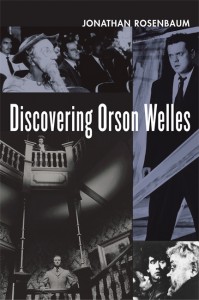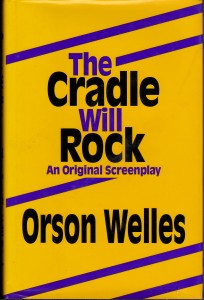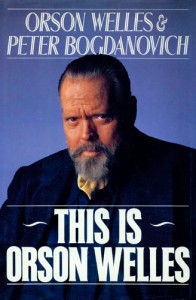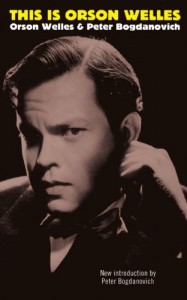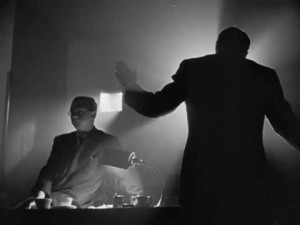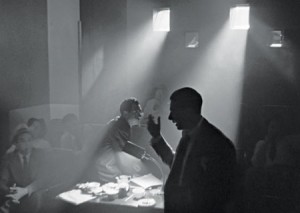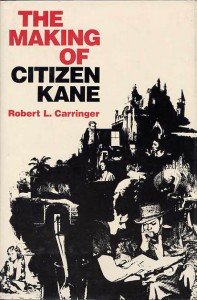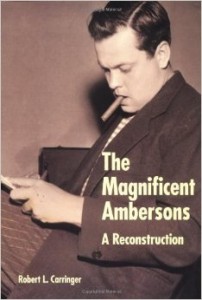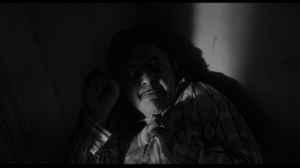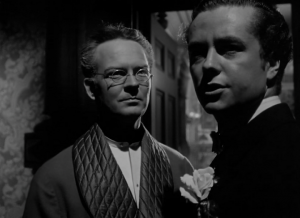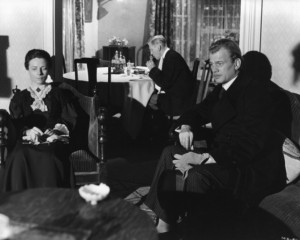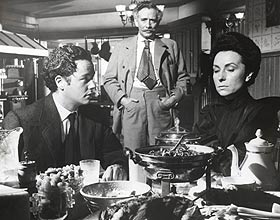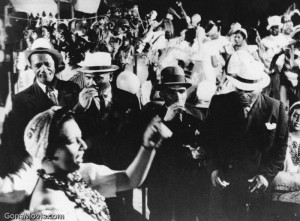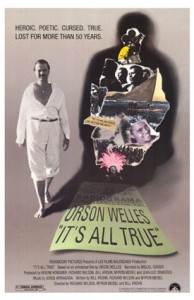Written originally for Trafic no. 12 (Fall 1994), where it appeared in French translation, translated by Bernard Eisenschitz; all three letters first appeared in English in Persistence of Vision No,. 11, 1995. The version here, including my introduction, comes from Discovering Orson Welles. — J.R.
This chapter -— the longest in my 2007 book Discovering Orson Welles, and in some ways my favorite -— was originally written for the French quarterly Trafic, and in fact was the first thing I ever wrote specifically for that magazine. The late Serge Daney (1942–1994) —- whom I’d known since his stint as editor of Cahiers du cinéma, when he’d gotten me to serve briefly as its New York correspondent (after Bill Krohn had shifted from that post to the same magazine’s Los Angeles correspondent) -— died of AIDS not longer after launching Trafic, and by my own choice, my first contribution, a memoir about working for Jacques Tati (see “The Death of Hulot” in my collection Placing Movies), was something I’d already written for and published in Sight and Sound. My second contribution was my brief introduction to Orson Welles’s “Memo to Universal”, an “outtake” from This Is Orson Welles that had been accepted by Serge’s coeditors (Raymond Bellour, Jean-Claude Biette, Sylvie Pierre, and Patrice Rollet) during Serge’s illness.
Early the next year, at the Rotterdam film festival, Sylvie proposed that I write something for the journal about Welles. Recalling Bill Krohn’s contribution to thefirst issue of Trafic (“Letter d’un ami américain,” Trafic, no. 1 [Winter 1991: 121–126]), I thought that our respective recent work on This Is Orson Welles and It’s All True could form the basis of an exchange of letters, and was delighted when Sylvie and Bill both agreed to the idea. And even though it took a little over eight months for Bill to respond to my first letter, I found it well worth the wait.
Bill had previously come to my rescue by reviewing the hasty French translation of This Is Orson Welles in the Cahiers. He explained in his review that my only serious disagreement with Bogdanovich, which I’d mentioned in a carefully written footnote, was about Peter’s suppression or alteration of a few passages from his interviews with Welles that didn’t conform to his standards of politesse or political correctness (such as Welles using the word “Negro,” as practically everyone else was doing, in 1969 — an example I’m citing now, but couldn’t mention then — as well as a few rude comments about Israel and other directors and actors that I hated losing). The careless French translation, to my horror, attributed all these changes to me rather than to Bogdanovich, so I was deeply indebted to Bill for setting the record straight.
The very title of this translation, I should add — Moi, Orson Welles — is lamentable, suggesting a form of egotism that’s not at all present in This Is Orson Welles, derived from the way Welles introduced himself on radio. Retaining this title is one of the battles I’m happiest about having won; at one point Peter wanted to call it Around the World with Orson Welles, which I argued against by maintaining that Mexico, the U.S., and two European capitals didn’t constitute the world. On the other hand, while going through a carton of memorabilia, Oja once showed me Welles’s passport from when he was around sixteen, and I was gratified to discover that they proved his claims about having been a world traveler by that age were not at all exaggerated. If, indeed, he and Peter had been able to follow through on the same pattern while conducting the interviews for this book, the title would have made perfect sense.
The passage I quote from Cy Endfield in my first letter is taken from the original published version of my “Pages from the Endfield File” in the November–December 1993 issue of Film Comment. When I revised and updated this piece for Movies as Politics, I omitted most of the extended material about Welles because it digressed from Endfield’s own story, but for anyone researching this period in Welles’s career, I think it’s well worth consulting.
I suspect that “the article from the 1940s” Bill alludes to in his letter (which he hasn’t read) that “describe[s] the difference between [Welles’s] conception and Eisenstein’s” is most likely Welles’s May 25, 1945, column for the New York Post — a fascinating comparative look at two then-current biopics, Wilson and Ivan theTerrible. If so, Bill gives a somewhat faulty description, understandable because it’s a secondhand account. What Welles is comparing is Russian and Hollywood filmmaking: “Because of the inferiority of Russian film stock, lenses and other equipment, the camera must assert itself by what it selects, and by the manner of selection. The Hollywood camera has a merchant’s eye and spends its time lovingly evaluating texture, the screen being filled as a window is dressed in a swank department store.” (James Naremore, incidentally, not only discusses this column at length in The Magic World of Orson Welles but also makes it the point of departure for his provocative monograph on Vincente Minnelli.)
Along with the following chapter, this article was read by Oja Kodar years after it was published, when I gave her a copy (unlike chapters 8, 10, and 18, which were all vetted by her prior to publication). I should note for the record that she subsequently confirmed my hypothesis that the disastrous misappropriation of footage from Welles’s Italian TV documentary series Nella Terra di Don Chisciotte in Jesus Franco’s edit of Don Quixote essentially filled the gap left by the omitted Patty McCormack material — which provided the film’s original narrative framework but which, based on her own sense of Welles’s subsequent plans for the film, she didn’t allow Franco to use. Unfortunately, it appears that the few other Welles scholars who’ve written about his Quixote in English have ignored this issue and assumed, like Franco, that In the Land of Don Quixote and Don Quixote belong together — when in fact the former was hackwork taken on by Welles to finance and otherwise facilitate the production of the latter.
***
October 1, 1993
Dear Bill,
I estimate it’s been about two years since you wrote Serge a letter for the first issue of Trafic, the last part of which was concerned with several anticipated developments concerning “the invisible Orson Welles.” By 1992, you correctly predicted, versions of Don Quixote and a “restored” Othello would be appearing, and the interviews with Welles conducted by Peter Bogdanovich in 1969 and 1970, which I had been editing since the late 1980s, would be published. You were also looking forward to the publication of Welles’s unrealized script for The Cradle Will Rock, written a year before his death, and I’m happy to report that while that publication has been twice delayed for financial reasons, it should finally be appearing next year, fall 1994, if all goes well. And while your hopes that The Merchant of Venice might finally surface haven’t yet been fulfilled, and our prospects for seeing The Other Side of the Wind or The Deep will continue to look dim until (or, rather, unless) some wealthy philanthropist can come up with the money to lure them out of hiding, there is the exciting news that the documentary on It’s All True started by Richard Wilson in the 1980s, including most of the newly discovered Fortaleza footage, is finally in the process of being completed by you and a few others; in fact, I look forward to seeing a press show in Chicago within a fortnight, shortly after it premieres at the New York film festival.
So generally speaking, the windfall of Wellesiana that you evoked in your letter is genuinely coming to light. But the consequences of this windfall remain somewhat ambiguous, especially in an American context — which is to say that none of these works is appearing in a neutral climate. More specifically, this is the curious form of hostility shown by certain American intellectuals towards Welles, a phenomenon that Welles himself commented on to Peter Bogdanovich: “Basically I’ve always been completely at odds with the true intellectual establishment. I despise it, and they suspect and despise me.” Considering the degree to which American academics now often take sides with the Hollywood studios and against Welles, extolling not only “the classical Hollywood cinema” (scarcely a neutral term in this context) but also the so-called “genius of the system,” it seems clear that what we’re facing once again, as you pointed out, is one institution (academic film study) paying homage to another (the studio system) over the body of an artist.
One indication of this is the publication of This Is Orson Welles, the Welles-Bogdanovich interviews, in the U.S. one year ago, which had all the status of a non-event. In the same issue of the New York Times Book Review that carried lengthy front-page reviews of the latest biographies of Yves Montand and David O. Selznick, the book received a flippant one-paragraph notice from a reviewer who, to all appearances, never got further than Peter’s introduction, and devoted 95% of his space to the book’s inception as it’s recounted there: “Like so many Wellesian projects . . . this one had a long and fitful history. It tottered through Welles’s lavishly documented decline even as Mr. Bogdanovich went on to direct such films as The Last Picture Show and Paper Moon.” In short, every effort made in the book’s 533 pages to counter the myth of Welles’s decline counted for so little that the reviewer was apparently unaware that such an effort had even been made. All in all, the book received so little attention that I was hardly surprised when, at the Rotterdam film festival last winter, a Portuguese friend asked me about the book — having read about its publication in an Italian newspaper — while one of New York’s leading film programmers was completely unaware of its existence. So it’s hardly surprising that fewer than 7,000 copies of the hardcover edition have been sold. On the other hand, I expect the paperback edition, due out this month, to sell much better, and while I don’t know the sales figures for any of the European editions, it’s already been apparent that the English and French reviews of the book, including yours in the Cahiers, have generally been more serious. (The best edition of all, I should add, is the just-published Italian translation brought out by Baldi & Castoldi — if only because they, unlike the others, were eager to incorporate all the factual corrections I’ve been able to gather from diverse sources over the past year.)
The conclusion is inescapable: in a climate where works are literally equated with markets, most of the works of Orson Welles continue to be not only invisible in the American marketplace, but non-existent; so a work by Welles about his own work necessarily has to follow the same law of non-presence, because who wants to read about works not currently showing? Actually, this ties in with your reference to Paramount’s commercially successful fiftieth anniversary rerelease of Citizen Kane in 1991, in prints that were so overlit (by Robert Wise, as you noted) that Joseph Cotten’s face became incorrectly recognizable in the projection room sequence. A related problem, one should add, was that the newsreel was made to look less grainy than it did in the original prints. These are relatively small matters, perhaps, but they seem to me highly symptomatic of a much wider problem when it comes to the understanding of Welles in the U.S. today. This is a period, after all, when the latest Hollywood releases are automatically guaranteed free publicity (usually disguised as journalism) on not only every TV and radio network, but on virtually every cable channel and in every newspaper and newsmagazine, simply as a matter of course — a privilege not extended to independent distributors who can’t afford junkets or TV interviews. Insofar as Kane itself was distributed in 1941 as an independent film that showed only in independent theaters — and, due to either pressure or feared pressure from the Hearst press, was not booked by any of the chains — I think it would be fair to conclude that if Kane were released in the same conditions in 1991, it would have suffered a similar fate at the box office. (How fortunate that your It’s All True is being distributed by Paramount!)
The crucial point to be made here, I think, is that Citizen Kane in 1991 was regarded as a Hollywood feature, and the “timing” or lighting of the print by Wise was done accordingly. But half a century earlier, what Kane mainly represented in the American cinema was an independent feature that made brilliant use of Hollywood studio facilities and some Hollywood conventions — which is hardly the same thing. In my opinion, the crucial ideological turning point in this change in public perception was Pauline Kael’s essay “Raising Kane,” originally published in The New Yorker thirty years after the film’s release. Explicitly conceived as a polemical riposte to la politique des auteurs as it was then understood in the U.S., popularized and somewhat modified by Andrew Sarris as “the auteur theory,” Kael’s essay set out to prove that the most important auteur of Kane was not Welles but Herman J. Mankiewicz. And despite the fact that her main piece of dubious evidence to support this contention — that the script of Kane was almost exclusively the work of Mankiewicz — was later definitively disproved, by Robert L. Carringer and many others, the principal subtext of her argument — that Kane belonged in the mainstream of Hollywood cinema (specifically as a culmination of the Hollywood “newspaper comedies” of the 1930s), a cinema that she and the American film industry alike regarded as a collaborative art — was eventually accepted by the public at large.
Significantly, this subtext is also the principal thesis of Carringer’s The Making of Citizen Kane (1985), a book now commonly regarded in this country as the standard, authoritative work on the film (along with the published script, to which Kael’s essay serves as the preface). And once this thesis became generally accepted, Kane was safe to become an unthreatening and much beloved Hollywood classic, a mainstream fetish object on the order of Casablanca — no longer a challenge or alternative to Hollywood but, on the contrary, a vindication of Hollywood, a virtual proof that disparate talents such as Welles, Mankiewicz, Gregg Toland, and others could be brought together to yield a single, satisfying, and ultimately relatively impersonal industrial product.
Of course, in order for a classic to become “timeless,” it has to be liberated from history and ideology, which is characteristic not only of the sort of treatment Kane gets from mainstream critics, but also what one finds in the fourth edition of David Bordwell and Kristin Thompson’s Film Art: An Introduction, currently a standard classroom text. Over the course of 25 pages about the film, devoted to narrative form and style, the relation of Kane to William Randolph Hearst is only alluded to, not explored, in two short sentences about what 1941 spectators would have been looking for — the implication clearly being that such a relation needn’t concern us today — while the issue of ideology, broached only under “notes and queries” as “the ideology of form,” is treated even more cursorily. From this standpoint, Laura Mulvey’s recent monograph on Citizen Kane in the “BFI Film Classics” series, arguing that “quite beyond Bazin’s conception of the ‘democratic’ nature of deep focus, the film is juggling with American myth, politics, and the collective psyche,” is especially welcome, persuasively tracing much of the film’s meaning and value to Welles’s anti-isolationism and anti-fascism before America’s entry into the war — a factor that indeed played a major role in all of Welles’s film projects apart from Ambersons and It’s All True that were most developed during this period: Heart of Darkness, The Smiler with the Knife, “Mexican Melodrama,” and Journey into Fear.
In fact, I believe that the avoidance of ideological meaning has direct bearing on the so-called “restorations” of both Othello and Don Quixote, on Carringer’s new book on Ambersons, and, perhaps most relevantly of all, on the work that you’re currently engaged in — defining both what It’s All True might have been and what the public perception (or, rather, misperception) of this project did to the remainder of Welles’s career. I realize, of course, that all these cases involve separate histories and circumstances, but at the same time I think they all have immediate bearing on the same fundamental issues.
How does one account for the fact that Orson Welles is mainly regarded in the U.S. today as a failed artist? To cite the fact that none of his American features was a commercial success when first released [with the exception of The Stranger] only begins to touch on the problem; far more significant, it seems to me, is the widely held belief that every feature after Citizen Kane represents some sort of betrayed promise, a dream deferred or denied. On the other hand, it’s likely that in certain contexts financial considerations merge imperceptibly into aesthetic judgments. At the tribute to Welles held at the Directors Guild in Hollywood in November, 1985, not long after his death, which we both attended, you’ll recall that Charlton Heston unhesitatingly described Welles as the most gifted director he ever worked for, but then demurred when Bogdanovich, who served as the host for the tribute, described Touch of Evil (1958), Welles’s last Hollywood film, as “a masterpiece.” Heston said that he preferred to call it “the best B picture ever made.” What he was saying, in effect, was that in America, to make the best B picture ever made means, on the bottom line, to be a failure. On some level, this strikes me as being at the root of the problem that kept Welles from making another Hollywood feature for the three decades of his life that followed Touch of Evil.
To inquire more deeply into the ideological ramifications of Heston’s belief is to ask a question about the difference between French and American responses that ultimately go beyond the issue of Welles as a special or isolated case. In the U.S. no one appears to be very curious about why the French take a different view of Welles, but in the case of Jerry Lewis, the so-called “French taste” has taken on some of the dimensions of a scandal and outrage — a position that manages to overlook the salient fact that Lewis’s entire career as a filmmaker could never have been launched, much less sustained, if his American popularity during the 1950s hadn’t been strong enough to support at the very minimum two Lewis features a year. To my mind, the refusal in America to take Lewis seriously is intimately connected to a reluctance to accept the embarrassing fact that on some level the Lewis persona and all that he represents is America: infantilism, retarded adolescence, nouveau riche taste and behavior, sexual hysteria, megalomania, and so on.
It appears that one can only get away with making a comparable sort of equation between America and Welles in the U.S. if one believes that his career basically began and ended with Citizen Kane. (One is reminded of the quote from F. Scott Fitzgerald — “There are no second acts in American lives” — that prefaces Eastwood’s Bird.) And I’m sorry to say that Carringer’s recent book on The Magnificent Ambersons, published by the University of California Press, mainly seeks to confirm this hypothesis. Both this book and This Is Orson Welles offer reconstructions of Welles’s original, 132-minute cut of Ambersons, and I should add that Carringer had full access to the RKO files while I had access only to materials relating to a book worked on by Bogdanovich and Welles twenty years ago (some — if not all — of which duplicated Carringer’s sources), which gives his work value even when his scholarship is debatable. (I’m especially grateful for his transcription of the full text of the comedy record playing in the background of Welles’s original ending, set in a boarding house.) Nevertheless, given these substantial material differences between our two projects, it is also worth asking what the theoretical and ideological differences are.
Now that I have the book before me, the answer is plain: Carringer’s critical position is an unqualified defense of RKO and just as unambiguous an attack on Welles’s position as neurotic and self-destructive. In many ways, his book is the ultimate tribute to Welles’s continuing potency as an ideological threat to the status quo of American film culture, the film industry in particular. Clearly, two books of vilification by Charles Higham, Pauline Kael’s “Raising Kane,” and Carringer’s own previous book were not enough to catalog the full range of Welles’s character defects, so yet another effort in this direction had to be made.
Carringer’s introduction is entitled “Oedipus in Indianapolis,” and he accurately summarizes it as follows: “The critical introduction is likely to be controversial. The Magnificent Ambersons has traditionally been considered a prime instance of the Hollywood system’s total disdain for mature artistry and its unrelenting commitment to destruction. To the contrary, I argue that Welles himself must bear the ultimate responsibility for the film’s undoing. While it is undeniable that [studio head George] Schaefer’s decision to recut The Magnificent Ambersons was primarily a business judgment, I believe it was a string of questionable judgments and rash actions on Welles’s part that predisposed this outcome.”
Significantly, the issue of whether Schaefer’s business judgment was questionable even from a business standpoint — Ambersons, after all, still lost money after being recut — is never raised. (On the other hand, apparently on the basis of a single humorous anecdote, Carringer claims that “Welles liked to depict Schaefer as something of a buffoon”– directly contradicting everything Welles said to me about Schaefer, all of it informed by obvious respect and gratitude, when I interviewed him in Paris about his Heart of Darkness project in 1972.) Carringer’s agenda is simply to show how Welles’s irrationality and bad decisions — the consequences of his own Oedipal fixations and his unwillingness to work through them — paved the way for disaster: “This is not to say that Welles acted irresponsibly; that he behaved evasively would be a more accurate characterization. Regarding each action, a vexatious personal involvement in the material was at play, and this factor overrode Welles’s aesthetic judgment.” If only Welles could have had Carringer around in the 1940s to force him to face up to his aesthetic obligations, one is made to feel, film history would have been radically different and everyone would have been happy.
Unfortunately, in order to evaluate Welles’s aesthetic judgment in such a context, one has to consider Carringer’s; and Carringer’s — hinging largely on Welles’s decision to cast Tim Holt rather than himself as George Minafer, and to keep this character out of the film’s final scenes — is so simpleminded and unreflective that it leads one to suspect that his ideal Ambersons would be even less interesting than the studio release version. The mere possibility that an uncharismatic, even grating treatment of George’s character might have suited Welles’s artistic purposes, or that Eugene Morgan (Joseph Cotten) and Aunt Fanny (Agnes Moorehead) might be equally important characters, isn’t even acknowledged. (Speaking as someone who regards Welles’s highly prissy performance as George in his 1938 radio version of Ambersons — included on Carringer’s excellent “deluxe” laserdisc edition of the film — to be anything but charismatic, I think the casting of Holt in the film could be defended even on these questionable commercial grounds; but Carringer won’t admit that such an argument can be made, so the discussion stops there.) Indeed, by never admitting that artistic and commercial concerns regarding Ambersons (both defined very simplistically) could ever be in serious conflict, Carringer bases his own analysis on an identification with Schaefer rather than an identification with Welles — the same bias adopted in his previous book, The Making of Citizen Kane. Without ever owning up to the fact, his new book is yet another attempt to rationalize the Hollywood studio system in relation to Welles, which means that every executive decision is taken at face value while every artistic decision becomes potentially suspect for “evasiveness.” To cite one random example of each: the first preview of Ambersons in Pomona is typically deemed “disastrous” without considering the fact that 53 of the 125 “comment cards” filled out were favorable and that some of these were as rapturous as anyone could wish. (These cards were preserved, as you know, by Dick Wilson, and a representative sampling is included in This Is Orson Welles.) On the other hand, Welles’s “puzzling “ failure to direct a stage or film version of Hamlet is deemed to be of major significance in pointing out his Oedipal defects, including his “evasiveness.” (In the latter discussion, one also encounters some slipshod scholarship: Welles’s “first directorial credit on network radio” was not “for a two-part Hamlet” — a program directed by Irving Reis — but for a seven-part Les miserables. And in his notes to the reconstruction, Carringer completely overlooks Welles’s stated reason — given in my 1972 interview in Film Comment — for his decision to omit an extended, virtuoso subjective shot of George Minafer exploring the empty Amberson mansion.)
It seems to me that any serious scholarly investigation into the matter of Ambersons has to move beyond simple blame and consider a complex of factors much wider (as well as more verifiable) than Welles’s attitudes towards his dead parents, Carringer’s principal obsession. Obviously, the work on It’s All True that Welles was doing in Brazil during the previews, recutting, and reshooting of Ambersons at RKO is of central importance, but Carringer, while arguing that Welles “behaved evasively,” is himself so unwilling to address this subject that he can’t bring himself to cite the words “It’s All True” once in his book, even in the bibliography. The implications of such a highly selective form of scholarship are embarrassing but inescapable: arguing that Ambersons was an “acting out” of Welles’s unresolved Oedipus complex, Carringer raises the question of whether he, like so many others, might simply be projecting onto Welles certain Oedipal fixations of his own.
I realize that my own fumbling efforts to defend the original ending of Ambersons in This Is Orson Welles by alluding to the endings of The Life of Oharu and Gertrud — inspired in part by simplistic assumptions about this ending by Carringer and others — are also probably suspect from a historical viewpoint, for no one can truly offer a critique of a sequence one hasn’t seen. In this respect, my recent interview with the former writer-director Cy Endfield (best known in France for The Sound of Fury/Try and Get Me! and Zulu), who entered the film business as an apprentice working for the Mercury unit at RKO while Welles was away in South America, is highly instructive. For whatever it’s worth, Endfield himself defends Welles’s original cut of Ambersons. It’s true that he hasn’t seen it for half a century, but at least he was present at all the original previews and many of the deliberations that went into the reshooting and recutting, unlike either Carringer or myself. He even recalls crying out in pain when he heard that the kitchen scene between Agnes Moorehead and Tim Holt — later to become one of the cornerstones of Bazin’s theory of deep focus! — was about to be cut, and speculates that his spontaneous display of grief may have even played a role in saving this sequence.
Endfield — a highly skilled magician, with some experience in theater directing, who had already attracted Welles’s attention through his card tricks — was hired by Jack Moss, who was left in charge of the Mercury during Welles’s absence, in exchange for teaching Moss at least one card trick that would succeed in confounding Welles when he returned from South America. This already tells one a little something about the kind of power plays that were at work in such a complex situation, even among Welles’s supposed Mercury allies. Let me quote just a single passage from Endfield’s comments about this experience, which leaves one with a very different impression from every other account I’ve read of how Welles’s instructions were being received at the time:
I sat with Jack Moss most days [in his office]. The poor man was spending his money on me wastefully, because he was not learning very much. He was naturally clumsy, and had no skill or aptitude for the card moves I was showing him. In the meantime, Orson was showing his anxiety in a number of long-distance calls he made to Jack. A telephone with a private line had been installed in Moss’s office in the Mercury bungalow that had a number known only to Orson in Brazil. For the first few days that I was with Moss, he had a few discussions with Orson and tried to placate him; then, they had started arguing because there were more changes [in Ambersons] than Orson was prepared to acknowledge. After a few days of this, the phone was just allowed to ring and ring, and I conducted many magic lessons when the phone was ringing constantly and uninterruptedly for hours at a time. I saw Jack Moss enter the office carrying 35 and 40-page cables that had arrived from Brazil; he’d riffle through the cables, say, “This is what Orson wants us to do today,” and then, without bothering to read them, toss them into the wastebasket.
I cite this passage not to offer any clinching evidence about ultimate blame in the Ambersons matter, which Carringer is so eager to have settled, but merely to point to the sort of personal testimony that often gets left out of the more “official” accounts. Needless to say, the surmises that we have to make about the original Ambersons are mere child’s play next to the deliberations you have to go through in making a documentary about a Welles film that was never even edited, much less brought to a rough cut form. I’d be eager to hear some of your own thoughts about this dilemma, especially now that you’re concerned with them on an active and daily basis.
As ever,
Jonathan

